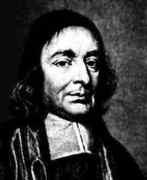Person: Wallis, John

John Wallis was an English mathematician who built on Cavalieri's method of indivisibles to devise a method of interpolation. Using Kepler's concept of continuity he discovered methods to evaluate integrals.
Mathematical Profile (Excerpt):
- He also studied logic at this school but mathematics was not considered important in the best schools of the time, so Wallis did not come in contact with that topic at school.
- In 1637 Wallis received his BA and continued his studies receiving his Master's Degree in 1640.
- One evening at supper, a letter in cipher was brought in, relating to the capture of Chichester on 27 December 1642, which Wallis in two hours succeeded in deciphering.
- This was the time of the Civil War between the Royalists and Parliamentarians and Wallis used his skills in cryptography in decoding Royalist messages for the Parliamentarians.
- In 1644 Wallis became secretary to the clergy at Westminster and through this he was given a fellowship at Queen's College, Cambridge.
- In this passage we have modernised Wallis's English a little to make it more easily understood.
- We talked above about two events which shaped Wallis's future, the first being cryptography.
- Wallis wrote a book "Treatise of Angular Sections" which remained unpublished for forty years.
- He also discovered methods of solving equations of degree four which were similar to those which Harriot had found but Wallis claimed that he made the discoveries himself, not being aware of Harriot's contributions until later.
- Wallis held the Savilian Chair for over 50 years until his death and, even if he was appointed for the wrong reasons, he most certainly deserved to hold the chair.
- This was not the only position which Wallis would hold at Oxford.
- Certainly Wallis's opponents believed that he became keeper of the University archives because of his support for Cromwell.
- Even if this were the case, as with the Savilian Chair, Wallis carried out his duties extremely well and fully deserved the post.
- Wallis contributed substantially to the origins of calculus and was the most influential English mathematician before Newton.
- Wallis's most famous work was Arithmetica infinitorum which he published in 1656.
- Wallis developed methods in the style of Descartes analytical treatment and he was the first English mathematician to use these new techniques.
- This work is also famed for the first use of the symbol ∞ which was chosen by Wallis to represent a curve which one could traced out infinitely many times.
- Wallis was also an important early historian of mathematics and in his Treatise on Algebra he gives a wealth of valuable historical material.
- In Treatise on Algebra Wallis accepts negative roots and complex roots.
- One highly controversial section in this work is one in which Wallis claims that Descartes' knowledge of algebra was gained directly from Harriot.
- Wallis received criticism for these claims immediately the book was published, but the subject is still of interest to historians of mathematics today.
- The claims made by Wallis on this topic have never been shown false to everyone's complete satisfaction.
- Wallis made other contributions to the history of mathematics by restoring some ancient Greek texts such as Ptolemy's Harmonics, Aristarchus's On the magnitudes and distances of the sun and moon and Archimedes' Sand-reckoner.
- Wallis became involved in a bitter dispute with Hobbes, who although a fine scholar, was far below Wallis's class as a mathematician.
- Wallis's book "Arithmetica infinitorum" with his methods was in press at the time and he refuted Hobbes claims.
- Wallis replied with the pamphlet Due Correction for Mr Hobbes, or School Discipline for not saying his Lessons Aright to which Hobbes wrote the pamphlet The Marks of the Absurd Geometry, Rural Language etc.
- One aspect of Wallis's mathematical skills has not yet been mentioned, namely his great ability to do mental calculations.
- It was a feat which was rightly considered remarkable, and Oldenburg, the Secretary of the Royal Society, sent a colleague to investigate how Wallis did it.
Born 23 November 1616, Ashford, Kent, England. Died 28 October 1703, Oxford, England.
View full biography at MacTutor
Tags relevant for this person:
Algebra, Analysis, Ancient Indian, Geography, Geometry, Origin England, Number Theory, Puzzles And Problems, Special Numbers And Numerals
Thank you to the contributors under CC BY-SA 4.0! 

- Github:
-

- non-Github:
- @J-J-O'Connor
- @E-F-Robertson
References
Adapted from other CC BY-SA 4.0 Sources:
- O’Connor, John J; Robertson, Edmund F: MacTutor History of Mathematics Archive
